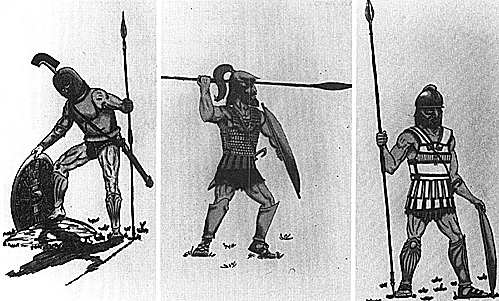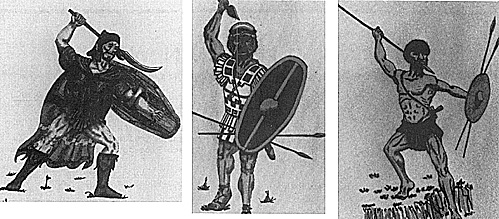 Left: Hoplite 450BC, Illyrian helmet, muscled cuirass.
Left: Hoplite 450BC, Illyrian helmet, muscled cuirass.
Center: Hoplite 500-350BC, Lamellar cuirass, Boetian helmet.
Right: Hoplite 400BC, thracian helmet, linen cuirass.
Greek Hoplite armies are both colorful and popular. Almost every major manufacturer of figures makes Hoplites. Part of the popularity is because Hoplites are regular troops that can have every figure painted differently. Mr. Thull not only gives a good overview of the period, he supplies some nice artwork to go with it. -- Kruse Smith, Ancient Editor.
Following the end of the Dark Ages and the Geometric Period in Greek history was the Classic Period (the age of the city-state), a time characterized by continuous warfare and bitter rivalries. The basic type of soldier was the hoplite; a heavy infantryman that fought in a dense linear formation called a phalanx. The hoplite got his name from the large circular shield that he carried called the Hoplon. It was constructed of wood with a thin metal face (usually of bronze), a central arm-loop and a hand-grip just inside the rim.
Most city-states required their citizens to buy and maintain their own arms and equipment. This led to a vast array of type, style, and quality. Only one state managed to get everyone to follow some sort of standards; Sparta. The Spartans usually fielded an army dressed in red cloaks with the Spartan symbol emblazoned on their shields.
The hoplite panoply was the outgrowth of centuries of development in the field of armor design. In his time the hoplite was the most heavily equipped soldier in service in the Mediterranean. Development continued as the period went on, the armor getting lighter and more flexible but sacrificing some of its protective qualities.
The hoplite panoply consisted of a helmet, shield, corselet, greaves, long spear, a short heavy sword, occasionally arm and leg guards, and at the beginning of the period a pair of lighter throwing spears orjavelins. Helmets came in a huge number of styles. The Corinthian was perhaps the most popular followed by a variety of other basic shapes and styles.
 Left: Peltast 600-450BC, Rhomphia (scythe like weapon) and theuros (shield).
Left: Peltast 600-450BC, Rhomphia (scythe like weapon) and theuros (shield).
Center: Peltats 500-250BC, Chacidian helmet, theuros, spolas javelin and spear.
Right: Psiloi javelinman entire period.
The shield was of wood and bronze, between 30 and 40 inches in diameter, and often painted with a mythological blazon. the corselet underwent considerable development during this period. Initially it consisted of a large rounded cuirass of beaten bronze called the bell cuirass. This type of protection soon fell out of favor; thin bronze not offering very good protection for the weight along with being uncomfortable and restrictive of movement. The replacement was the muscled cuirass; it followed the shape of the body and consequently could afford a greater thickness of metal. Another type of protection that was parallel to, and largely replaced, the metal cuirass was the spolas. This was made of several thicknesses of linen or canvas glued together. This was considerably lighter and had a higher degree of flexibility. Although it did not provide as good a protection as the muscled cuirass, it did cover more of the body via hanging strips called pteryges, these hung from mid- thigh to the knee and from the shoulder to the elbow. The spolas was often also reinforced with small bronze plates called lamellae at critical spots.
Greaves were produced from thin sheets of bronze and were sprung in such a way as to grip the leg. Arm and thigh guards were made in a similar fashion but never became popular, they were expensive, heavy and those areas of the body were already covered by the shield.
For weapons the hoplite carried a spear, sword, and occasioally javelins and a dagger. The spear was between six and nine feet long and was usually thrust overarm with one hand. Typically it had an iron head measuring between six and eighteen inches in length, and had a bronze buttspike on the other end. Both of these were socketed to fit over the shaft (to help reduce splintering). A grip, usually of wound cord, was at, or near the balance point of the shaft, to facilitate grasping the shaft and to prevent the spear from slipping in a sweaty hand. Thesword was made of iron and abouttwo feet in length with a straight cross guard and a bone or wooden handle wrapped with leather. An alternativetype of sword was called a Kopis. This was single edged and curved slightly, with the sharp edge along the inside of the blade. It was used almost exclusively for slashing. The kopis seems to have originated in Italy, (8th Century, B.C.), and became popular in Greece during the 6th Century, B.C. Daggers, although they are noted in written sources, are rarely seen on monuments and probably were not part of normal hoplite equipment. The lighter throwing spears that were falling out of use at the beginning of the period, were usually about five feet in length with bronze or less often, iron heads.
Hoplites were supported (and eventually supplanted) by lighter troops and cavalry. The lighter troops fell into two classes; Psiloi (also called Gymnets) and Peltasts. Psiloi translates (very roughly) as "skirmisher" or light infantry. They wore no armor but often carried a shield of wood or wicker with a leather cover, and were armed variously with javelins, slings, and bows; javelins being by far the most popular. They were used for skirmishing ahead or on the flanks, taking or covering rough ground, neutralizing opposing light infantry, and harassing the flank of the opposing phalanx. The Peltast was originally of Thracian origin, and many were recruited from there throughout this period. The Peltast was used as a link between the Hoplites and the Psiloi and for driving off enemy light troops. The Thracian troops wore distinctive costume of his homeland consisting of a fox-skinned cap, high boots, and brightly colored cloak. He carried a crescent- shaped shield called a pelta (from which this troop-type derives its name) and carried several javelins and normally a sword of some type.
The Greek Peltast sometimes substituted a round shield for the pelta and often carried a heavier spear for thrusting along with his javelins. The Greek often added a helmet to his equipment, and later in the period, a spolas. Cavalry at this time were of two types; a home-grown type that consisted essentially of a hoplite-equipped rider (without shield) and used as a close-order heavy cavalry, and a number of foreign mercenaries (mainly Thessalians) that were used as light skirmishing cavalry.
I have included some drawings of my own to give an idea of how the Greeks looked. If you are interested in more information on the Greeks, there are a number of books on the subject. Some of them are: Connolly, Peter; The Greek Armies Connolly, Peter; Greece and Rome at War Nelson, Richard; Armies of the Greek and Persian Wars.
The Nelson book, although not a historical account, is lavishly illustrated with color photos of Greek art and has many good pictures of original works portraying soldiers of this period.
For general reading, several Penguin Classic books are very good: Xenophon; The Persian Expedition Heroclotus; The Histories Thucyclicles; The Peloponnesian War.
Back to Table of Contents -- Courier Vol. VII #2
To Courier List of Issues
To MagWeb Master Magazine List
© Copyright 1986 by The Courier Publishing Company.
This article appears in MagWeb (Magazine Web) on the Internet World Wide Web.
Other military history articles and gaming articles are available at http://www.magweb.com